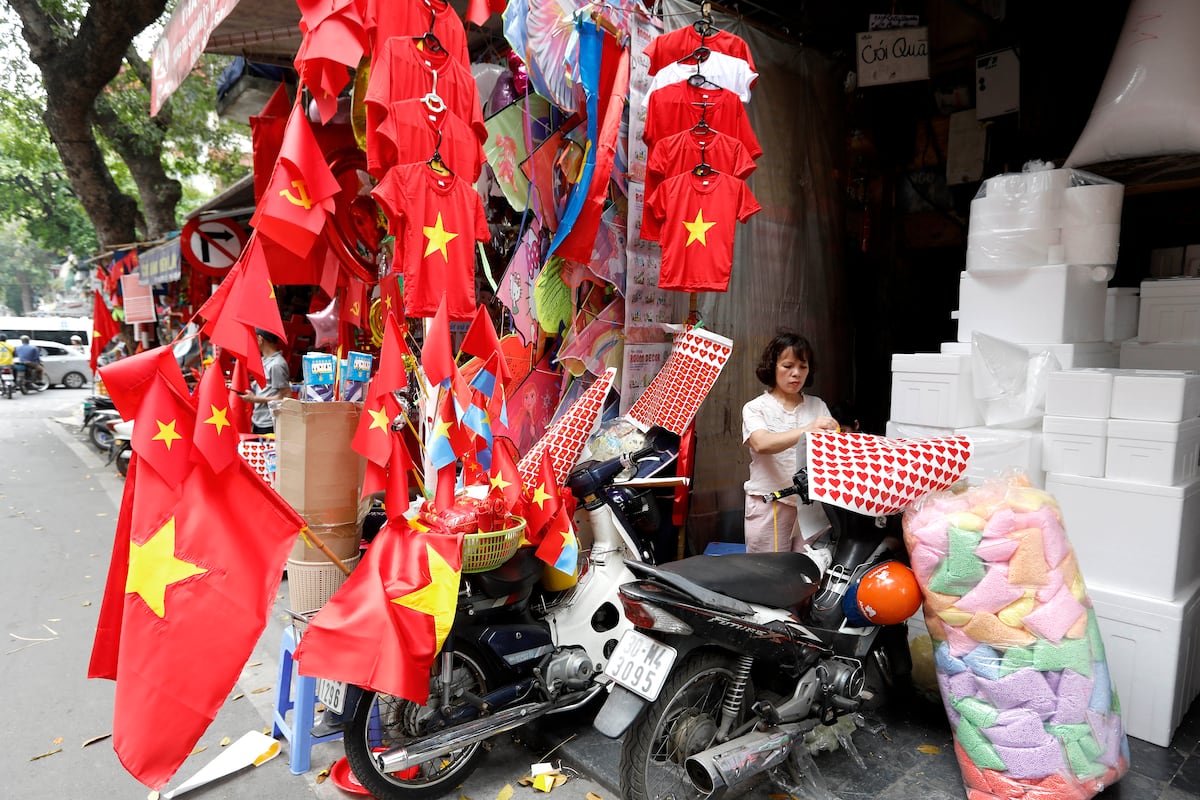[ad_1]
Half a century after the end of the Vietnam War — commemorated on April 30 — the Asian nation once again finds itself at the heart of a global power struggle. Now transformed into one of the world’s most dynamic economies and a manufacturing and export powerhouse, the Socialist Republic of Vietnam is caught between two competing forces vying for control over global supply chains: China and the United States. This battle is being waged through tariffs, sanctions, and geo-economic maneuvers, placing Vietnam in a position that is both strategically crucial and highly delicate.
Its industrial boom has brought Vietnam under the spotlight of U.S. President Donald Trump’s renewed protectionist crusade. The United States — Vietnam’s main customer and strategic partner — has threatened to impose tariffs of 46% on all Vietnamese goods starting in July unless an agreement is reached before the current 90-day global pause comes to an end.
At the same time, China — Vietnam’s largest supplier and neighbor, with which it has ongoing territorial disputes in the South China Sea — has warned it will retaliate against any countries that strike trade deals with Washington that are detrimental to Beijing’s interests.
Vietnam was the stage for conflicts that shaped its development throughout much of the 20th century. After reunification in 1976 and the launch of the doi moi reforms a decade later, the country began a modernization process that transformed it. From a centrally planned and impoverished economy, it integrated into global markets and attracted foreign investment.
Vietnam’s nominal GDP per capita has multiplied more than eightfold — from under $500 in 1986 to nearly $4,300 in 2023, according to the World Bank — while extreme poverty has fallen to under 2%. Except for the pandemic years, its economy has sustained uninterrupted growth for 25 years, averaging an annual rate of 6.25%, the highest in the Association of Southeast Asian Nations (ASEAN).
With a population of 100 million, Vietnam is one of the most vibrant countries in the region. This vitality is evident in its bustling streets, rapidly expanding infrastructure network, and the energy of its young and connected population (the average age is 33). Its combination of stability, relatively skilled labor, and openness to trade has made it a leading destination in the so-called “China Plus One” initiative — a strategy to diversify production in response to trade tensions that began during Trump’s first term.

Tech giants (like Samsung, Foxconn, and Intel), textile companies (Nike, Adidas, and Uniqlo), and machinery and engineering manufacturers (Bosch Rexroth and ABB) have expanded their production in Vietnam to circumvent the tariffs imposed on China since 2018. LEGO has also bet on the country, recently opening one of its largest factories in the world.
In addition to its strategic location in Asia, Vietnam offers preferential access to major markets thanks to a robust network of trade agreements. It is a member of two of the world’s largest free trade areas by GDP — the Comprehensive and Progressive Agreement for Trans-Pacific Partnership (CPTPP) and the Regional Comprehensive Economic Partnership (RCEP) — and has signed 15 other free trade deals, including with the European Union, Japan, and South Korea.
As a result, Vietnam has become a key cog in global trade. But its role as a top destination for offshoring is a double-edged sword. Thirty percent of its exports end up in the United States, more than anywhere else in the world. In 2024, Vietnam’s exports to the U.S. reached $136.6 billion, according to official customs data — nearly triple the $47.58 billion it exported in 2018, the year the first phase of the U.S.-China trade war began.
Although Vietnam has massively scaled up production, it still lacks a solid base of local suppliers for components, machinery, and raw materials. That makes it heavily reliant on others to fuel its factories and sustain growth. Chief among them is China, which has become Vietnam’s top supplier. In 2024 alone, Vietnam imported around $144.5 billion worth of goods from China, up from about $65.44 billion in 2018.
This high dependence has fueled the perception that Vietnam functions primarily as an assembler of goods made with foreign components, and Washington fears it may be used as a backdoor to sneak Chinese goods into the U.S. According to data from the OECD and WTO, the Chinese value-added content in Vietnamese exports rose from 0.4% in 1995 to 13.8% in 2018.
The tariff exemptions on electronics — which account for a large share of exports — and the current pause on new levies have softened the immediate blow. But negotiations are now on the table. Although Trump’s trade policy remains murky due to constant reversals, the prevailing view is that he aims to isolate China by pressuring its partners to curb economic ties with Beijing.
In April, trade officials from Vietnam and the U.S. began talks, though few details have been made public. Vietnam currently holds the fourth-largest trade surplus with the U.S. — $123.5 billion in 2024 — and the White House is considering new rules of origin to prevent Chinese transshipment through Vietnam.
In a gesture aimed at appeasing Trump, Vietnam is preparing to step up inspections on Chinese goods crossing its border en route to America. However, Alicia García Herrero, chief Asia-Pacific economist at Natixis, warns that Vietnam’s room for maneuver is limited.
“Vietnam’s decoupling from China is practically impossible,” she says. García adds that the country is in a worse position than in 2018 “because of the extreme situation: massive imports from China and massive exports to the U.S.”
Moreover, any attempt to impose its own tariffs on China — as Washington may demand — would hurt Vietnam’s competitiveness and create friction with Beijing. At the same time, there are growing fears that China’s overcapacity, fueled by state subsidies, could flood the market and jeopardize Vietnam’s industrial base.

Vietnam, which has spent decades cultivating a foreign policy based on balancing the two superpowers, is finding its room to maneuver increasingly limited. This was evident during the recent visit by Chinese leader Xi Jinping, which concluded with 45 agreements but saw no amplification of his message about “opposing unilateral intimidation” — a clear veiled reference to Washington.
“Vietnam doesn’t want to give the impression that it’s trying to screw the United States, as Trump put it,” says Nguyen Khac Giang, visiting fellow at the ISEAS-Yusof Ishak Institute. “Now it’s being forced to pick a side, at least economically. But it has good reasons not to, because both choices carry risks.”
In China — which is the only country facing 145% tariffs — all these moves are being closely watched. Not only by the government, which has expressed its willingness to respond, but also by businesspeople who relocated their factories to Vietnam. Still, the hope that tariffs will remain relatively low (Vietnam aims to reduce them to a range between 22% and 28%) has fueled new projects, according to Hanna Wang, a cross-border trade content creator. Chinese social media is filled with posts by entrepreneurs based in Vietnam; EL PAÍS contacted five of them, but all declined to comment.
Decisive path
The road ahead is critical. Vietnamese leader To Lam — who has been in power since last summer — aims to transform the communist nation into one of Southeast Asia’s top commercial and investment hubs by 2030, and into a high-income economy built on technology, knowledge, and advanced manufacturing by 2045. Vietnam has set a GDP growth target of 8% for 2025 and hopes to push it into double digits in the coming years. In that plan, increasing exports to the United States is a key pillar.
But it won’t be easy. The International Monetary Fund has lowered its growth forecast for Vietnam from 6.1% to 5.2%, and analysts at Natixis estimate that “if reciprocal tariffs persist, it could fall below 3.5%,” warns García.
Tran Dinh Lam, director of the International Cooperation Program at the Center for Vietnamese and Southeast Asian Studies, insists the solution lies in “maintaining our strategic autonomy and ensuring national private investment.” Lam says the country is working to strengthen ties within ASEAN and with “middle powers” such as Japan, South Korea, Australia, and India, and is also seeking to deepen relations with the EU — Spanish Prime Minister Pedro Sánchez visited recently — to maintain a stable trade order.
Giang agrees with that approach: “Hanoi is trying to make friends.” But he notes that the success of this effort “will depend on how it’s received in Beijing and Washington.” The analyst believes that although the intensifying rivalry between the world’s two largest economies “doesn’t seem likely to end anytime soon,” “I don’t see a scenario where Vietnam becomes a full ally of either one,” he concludes.
Sign up for our weekly newsletter to get more English-language news coverage from EL PAÍS USA Edition
[ad_2]
Source link







Comentarios